[ad_1]
It’s day two of lockdown 2 and a perfect night for watching football: cold and crisp with a slight mist descending. Ninety minutes before the kick-off, I’m outside St Mary’s Stadium in Southampton. Around me is the occasional patrolling steward and a few TV technicians carrying kit into the ground. The silence is interrupted only by the cracks of fireworks from across the city.
Suddenly a loud bellow from just beyond the waist-high perimeter fencing shocks me. “Come on you Reds,” a cyclist shouts as he pedals by. He looks at me and shrugs: “Well someone has to say it, haven’t they?” On he goes, repeating his chant as he disappears into the darkness. By the end of the evening, Southampton will be top of the Premier League for the first time.
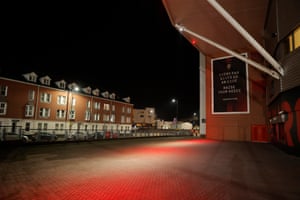
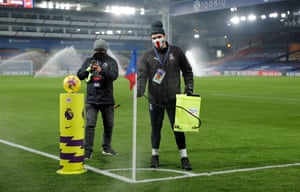
In June, when Project Restart was in its infancy, football behind closed doors seemed like a quirky interruption. We were all just so glad to have it back in any form. How we smiled to see crossbars being sprayed with disinfectant and away teams emerging from unusual corners of the stadium, perhaps having changed in a version of the groundsman’s hut.
Those motivational tarpaulins masking empty seats, resplendent with club mottos, were colourful and cheery. It was summertime, there were five substitutes allowed and drinks breaks. Now that all seems a long time ago and it feels very different.
With winter here, darkness has enveloped the grounds; the floodlights are on, bathing not only the pitches but also the surrounding communities in a milky glow. From outside it is now even more obvious that a game is going on, a clear beacon to fans that a party is happening and they don’t have an invitation. It is seven months since football returned. Through all this I have been a lucky one: a photographer – one of the few to be let in.

I’m in Liverpool on the opening day of the season and I have time to spare before a tantalising match between the champions and promoted Leeds. On the gable end of a house in a typical Anfield street is a newly painted mural of Jordan Henderson lifting the Premier League trophy.
As I photograph it, a woman takes out her phone and does the same. I cannot help but feel guilty, I’m off to see this fascinating match and she almost certainly is not. I think of her again after the match and feel even worse. A breathtaking game has ended 4-3, the sort of game that lifts your heart and confirms why you love football, why you go through the turnstiles to watch it.
A couple of days later I am on the other side of the Pennines for Sheffield United v Wolves. The talk on the radio is of a possible return of fans. There is a sense of positivity that we will be out of this before long now. Wolves score two early goals and I imagine the vitriol that would have poured down from the vast Kop stand behind me.

Filling out health clearance forms and temperature checks are now part of my routine, like packing my camera bags. At Chelsea in early October, having lugged my gear to the front entrance, I am hot and sweating. The temperature steward aims the little white gun at my forehead. “That’s 32.2,” he says. “Surely I’d be having organ failure if that was true,” I reply. The steward duly waves me through.
I have done quite a few games at Chelsea in recent months and have talked with a friendly steward who hands out our sanitised photographer bibs. She tells me how fearful she is for some of the regulars in the West stand, especially for their mental health. She recalls how coming to the ground, seeing everyone there, being part of that community, has been like having a second family, helping her through some difficult personal times.
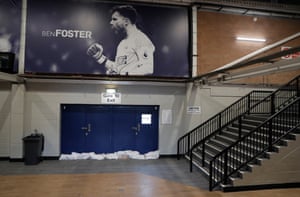
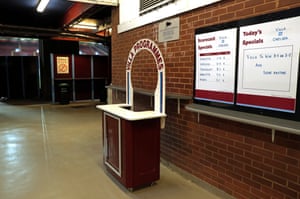
Just before a match starts, I have often found myself walking the empty concourses behind the stands. Before, these places would be vibrant and buzzing with anticipation; places where friends would meet up, drink and laugh, around them walls painted in club colours. Now they are like haunted houses.
Evidence of what used to be keeps popping up – the bookies odds for first goalscorer still scrawled up on whiteboards, adverts promoting events in March. I can’t stop staring at the ones imploring people to go to the now notorious Cheltenham Festival in 2020.
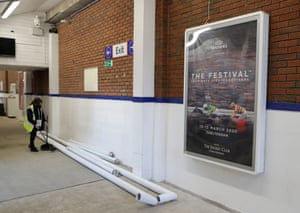
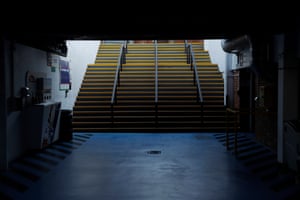
At Selhurst Park, I have been able to go to the back of the Arthur Wait stand and retrace the steps I used to take as a kid. Back then it was always down the same set of steep stairs from the same turnstiles on Park Road to the concourse at the back of the stand then out to the terraces or seats. The memories flood back.
Come Halloween, I’m in a rain-lashed Sheffield to see United take on Manchester City. My allotted parking place is by a wall where names of fans are chiselled into each brick. On the other side of this wall, a dozen sodden fans are peering over, trying to get a tiny glimpse of the players getting off their buses.


Before the game I chat to a steward. “It’s bonkers,” he says. “They’ll be ramming into pubs right now and as long as they have a pie with their pint, they can watch this match on a big screenWhy can’t some sit and watch it in here?”
On the drive home, I hear on the radio the prime minister announce another national lockdown. The prospect of fans being back in grounds such as Bramall Lane seems a distant hope.
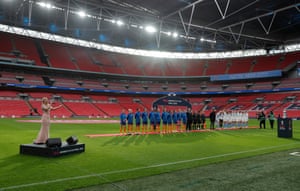
An empty Wembley is the ultimate echo chamber on a matchday.When the players from Manchester City and Everton lined up before the Women’s FA Cup final to hear an immaculately dressed singer belt out Abide with Me, the anthem performed at just about every Cup final since 1927, it is eerie. I am so used to a huge crowd participating. The hymn’s meaning seems even more moving right now, given the pandemic. The emptiness of the stands feels almost crushing.

During the past few months, the fans I have felt most sorry for are probably those of Brentford and AFC Wimbledon. Both clubs have moved into new stadiums, usually a time for celebration, but this has not happened. Only at the beginning of December did a few Brentford fans get the chance to sample their new home.
It was in early September that I attended the first competitive match there. The perfect grass, cutting-edge architecture, multicoloured empty seats – it felt like I was watching a video game. I was also at the new Plough Lane for the “grand” opening of the ground, 29 years after they played their last game nearby as Wimbledon FC.
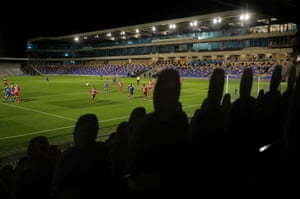
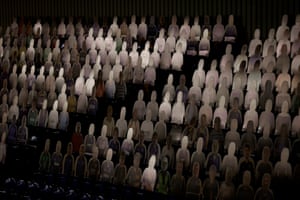
The only presence of the Wimbledon fans who resurrected the club in 2002 is themselves as cardboard cutouts. It was a bittersweet night. My friend and colleague Daffydd, a lifelong Dons fan, has been suffering awfully with motor neurone disease. The next day I email Daff to tell him how great the stadium is and that the managing director has promised to get him there as soon as possible. He doesn’t reply. Five days later Daff passes away.

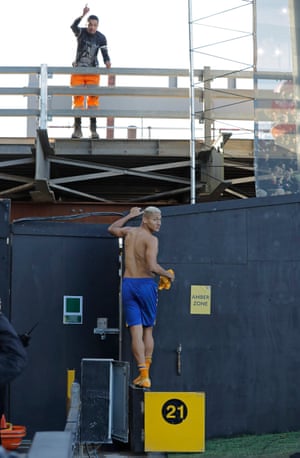
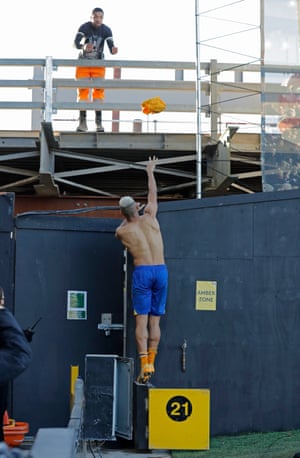
In late November, I’m at Fulham v Everton. A new stand is being built on the river side of the ground . At the end of the match, a workman emerges from the building site, speaking Portuguese. He persuades Richarlison, Everton’s Brazilian forward, to give him his shirt. Richarlison, seeming only too happy to be speaking to a real fan, climbs up and throws him the memento.
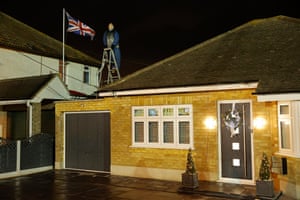
In Canvey Island, Essex, Steve Marks is up a ladder erected on the flat garage roof next to his bungalow. A huge Union Jack is stiff to the breeze on a flagpole behind him as a freezing cold squall blows through. Fully decked out in waterproofs, he looks like the captain of a ship steering through a storm.
About 50 yards away his team are playing their biggest match ever, a second-round FA Cup tie against Boreham Wood, which is live on BT Sport. “I couldn’t miss this,” he says, twirling his old-fashioned rattle, the sort that only seems to come out for cup ties. Other fans are on ladders, banging on a blue corrugated iron fence that rings the ground. “Two days later and we’d be in there,” one says, referring to the end of lockdown . “Typical, the biggest day in our club history and look at us.”
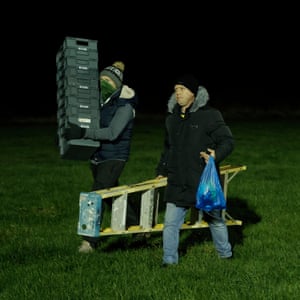


With about five minutes to go, Boreham Wood’s burly centre-forward, Matt Rhead, nods in the third goal. Throughout the match he bore the brunt of the chants from the Canvey Ultras. He laps it up, playing the pantomime villain to perfection, joined by his teammates. Boy, how I’ve missed this – the moment when a goal is scored, when scorers and fans unite. It’s the whole reason and point of the game.
When fans are not present, you can hear the net ripple and the scorers don’t know what to do with themselves. It usually ends up in a tame high-five or a polite handshake as if we are back in the 1950s. At least with a few spectators to see them, the players have got a reason to unfurl their best routines and a goal is celebrated properly.
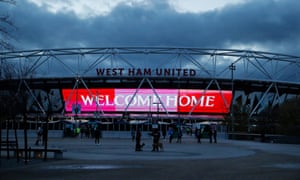
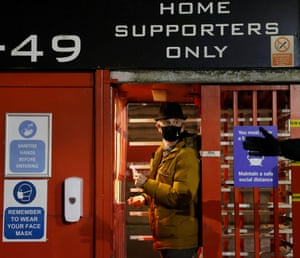

The lockdown is lifted on 2 December and clubs in tier 2 areas are allowed to host 2,000 spectators at matches. This means a whole new world for the fan, one of arrows, one-way systems and advice everywhere. At West Ham, the huge screen on the side of the London Stadium scrolls through slides saying ‘welcome home’ and then urges ‘hands, face, space’.
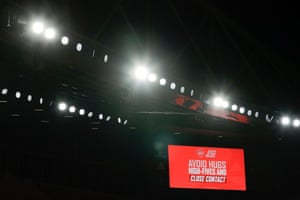
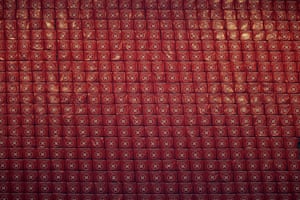
At Brighton, Southampton are the first visitors to play in front of fans. James Ward-Prowse is about to take a corner in front of the baying Seagulls supporters in the North stand. The hulking figure of Jannik Vestergaard, the Southampton centre-back, slowly walked into the penalty box. “Oi, Vestergaard, you mutant,” one wag shouts. The rest of the fans laugh. Everyone, including all of the players, hears it. The ball is crossed in and flies off the centre-back’s forehead into the net. Cue exuberant celebration.
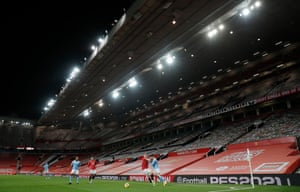
As Old Trafford is in tier 3, fans still cannot attend. The 80th Manchester derby to be played there is the first behind closed doors. It is a dreadfully dull game and the lack of passion on and off the pitch cripples the spectacle. These sporting cathedrals were built to enable many people to watch football together. The sermon is still being preached but there is no congregation, no hymns to reverberate round the cobwebbed pews.
Football grounds are also places for socialising, for seeing friends and for escaping reality for a few precious hours. It is not for nothing that fans refer to their ground as “home”. Think about why West Ham greeted their fans back with a welcome home message, why there is a banner inside Old Trafford saying “we can’t wait to welcome you home”. For millions of fans, their club’s ground is a place where they feel safe and secure, where they can share emotions both good and bad.
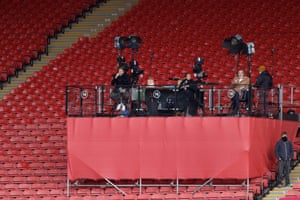
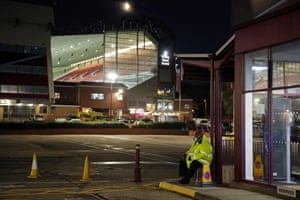
So here we are now, seven months on from the restart of football. This pandemic has reinforced how important fans are to the game: they are the foundation on which these clubs are built. Players come and go, but the fan is there, supporting their teams with pride and passion.
I look on with envy as grounds are packed out in Australia and New Zealand while our national game limps on through the hardest of winters. I can’t wait for it to break free of this cocoon-like state and a return to the football we all know and love.
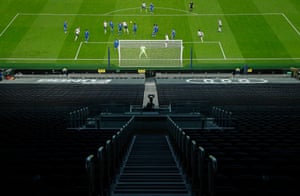
For Daff, a great man who loved his family, his football and his photography.
[ad_2]
Source link